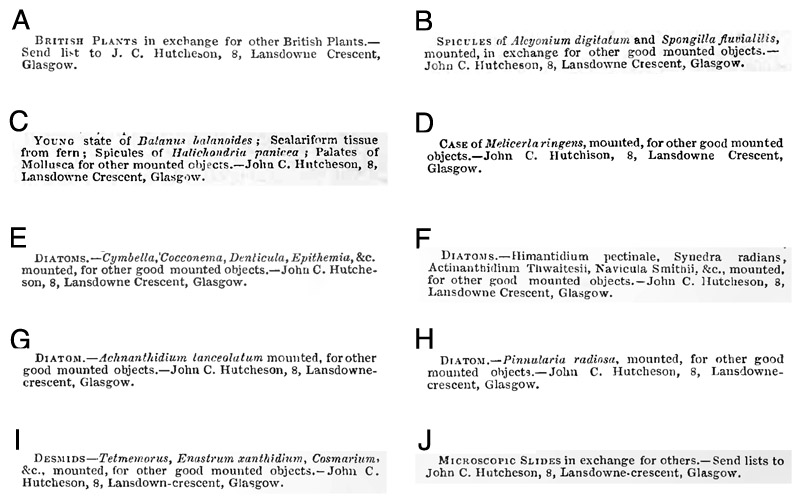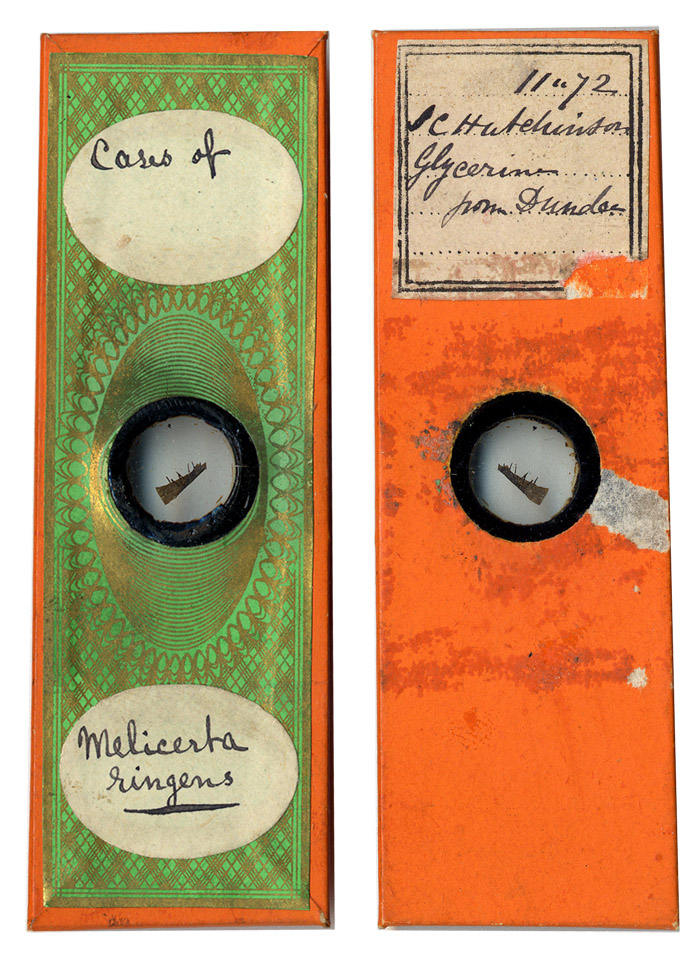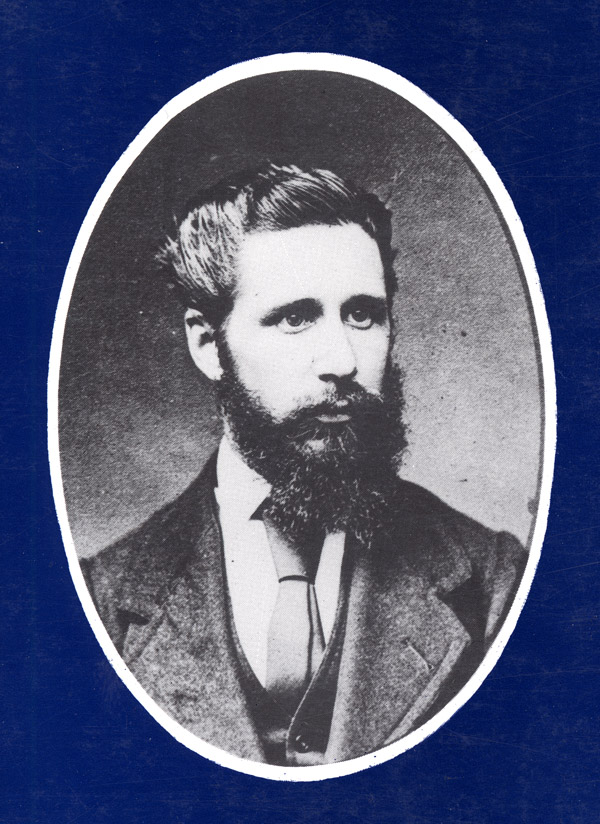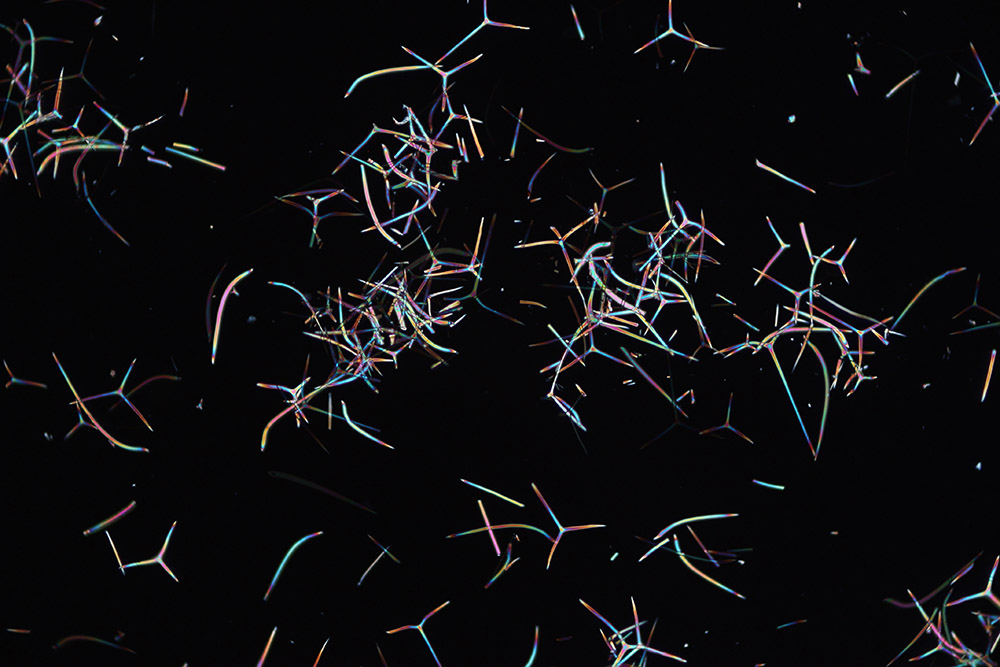John Cross Hutcheson, 1843 – 1921
by Brian Stevenson
last updated January, 2020
John C. Hutcheson was an amateur microscopist, apparently making slides for his own enjoyment and for exchange with other people (Figure 1). He advertised for slide exchanges in the popular scientific magazine Hardwicke’s Science-Gossip for a fairly brief period, between 1872 and 1875 (Figure 2).

Figure 1. Several microscope slides that were made by John C. Hutcheson. The two diatom mounts match the descriptions of slides advertised by Hutcheson for exchange in 1873 (see Figure 2E and H). The notation “CB” indicates that the diatoms were mounted in Canada balsam.

Figure 2. Exchange
offers from John Hutcheson advertised in Hardwicke’s Science-Gossip between
1869 and 1875, including descriptions of all his offered microscope slides. I
did not find any detailed information on Hutcheson’s involvement with
microscopy after 1875.
(A) 1869. Hutcheson’s exchange offers between 1869 and the beginning of 1872 dealt only with plants/dried plants.
(B) 1872, Hutcheson’s first offer to exchange microscope slides.
(C) 1872.
(D) 1873. A slide of this same subject was acquired from Hutcheson by Edward Ward, apparently in 1871 (see
Figure 3).
(E) 1873. A slide containing this mixture of diatoms is shown in
Figure 1, left.
(F) 1873.
(G) 1873.
(H) A slide containing this mixture of diatoms is shown in Figure 1, right.
(I) 1873.
(J) 1874, appeared one time that year. Essentially the same, vague exchange offer appeared once during 1875.
John Hutcheson was born 1 April, 1843 in Glasgow, Scotland.
He was the second son and third child of James and Frances Manson Hutcheson.
Three additional siblings followed. Father James and his brother, George, owned
J & G Hutcheson, a cotton yarn company. During the 1850s, the Hutcheson
family moved from 64 Buccleuch St. to 8 Lansdowne Crescent, also in Glasgow.
John Hutcheson lived in that house until he died, at the age of 78.
By 1861, John was working as a “mercantile clerk”, quite likely in his father’s business. The 1871
census recoded him as being a “warehouse salesman”, again probably working for
his father. John’s father, James, died in 1874, although the family remained
fairly well off. At least one, and usually two, servant and cook was recorded
as living with the Hutcheson family on all censuses. I have not located John
Hutcheson on the 1881 census. The 1891 census, his 1897 marriage record and his
1921 death record state his occupation to have been “iron founder”. According to Eunson (1989), this was the Gowanbank Foundry in Glasgow.
The earliest record of Hutcheson’s involvement in scientific
studies is an 1869 exchange offer that he posted in Hardwicke’s Science-Gossip (Figure 2A). That ad, and several others
over the next 3 years, requested exchanges of plants. Beginning in 1872,
Hutcheson posted exchange offers for microscope slides, initially of sponge
spicules, but later to include diatoms, fern tissues, mollusk radula and other
items (Figure 2B-J). In 1873, he offered to exchange mounts of “case of melicerta ringens” (Floscularia ringens). Edward Ward, at that time an amateur microscopist, repapered a microscope slide with that description, and labeled it as
having been obtained from J.C. Hutchinson (sic) (Figure 3). Ward dated the slide 1872, suggesting that Hutcheson
posted exchange offers in other, as-yet unidentified magazines.

Figure 3. A microscope slide of “case of melicerta ringens”. The slide was re-papered by Edward Ward, who noted that he received it from J.C. Hutchinson (sic).
Hutcheson’s Science-Gossip
exchange requests ended near the time of his father’s death, with offers appearing
once each in 1874 and 1875. This may have been due to Hutcheson having to
devote more time to work and less to play after his father’s death.
Alternatively, he may have inherited money such that he could readily purchase
slides, rather than spend time making them for exchange.
Hutcheson was listed in The
Naturalists’ Directory for many years, through at least 1905. He was noted
as being involved with microscopy. I have not located any further records that
could add details.
In April, 1884, a colleague of Hutcheson’s made a
presentation of their work to the Royal Philosophical Society of Glasgow: “Dr. James J. Dobbie gave a ‘Demonstration of
an easy and rapid Method of determining the Specific Gravity of Solids’,
invented by Mr. John C. Hutcheson and himself, for
which the authors received the thanks of the Society”. This may have been
an offshoot of Hutcheson’s work with the iron foundry.
John was elected a member of the Royal Philosophical Society
of Glasgow in late 1899: “The Chairman
intimated that Mr. John C. Hutcheson, Iron founder,
8 Lansdowne Crescent, had been duly elected a
Member of the Society, on the recommendation of Dr. M'Millan, Professor
Henderson, and Dr. Fergus”.
A book of photographs by John Hutcheson was published in
1989 by Eric Eunson, entitled Crail, 1889.
John Hutcheson married Helen Campbell Moodie in 1897, when
he was 54 and she was 35. Until that date, John’s two unmarried sisters, both
also in their 50s, had lived with him at 8 Lansdowne Crescent. After John’s
marriage, the sisters moved to Glasgow Kelvinside. John’s wife died some time
prior to 1921. John died November 29, 1921, from colon cancer, at the age of
78.

Figure 4. Photograph of John C. Hutcheson, date unknown. Reproduced from the book "Crail 1889", by Eric Eunson, by permission of Stenlake and McCourt, publishers.

Figure 5. "Spicules of Grantia compressa" (a sponge), prepared by John C. Hutcheson, ca. 1875 (see Figure 1). Photographed between crossed polarizing filters, with a 10x objective lens and C-mounted camera.
Note: the
microscopist John C. Hutcheson should not be confused with another, more famous
Scot. John Conroy Hutcheson was a noted author of adventure stories such as The Wreck of the Nancy Bell: Or Cast away on Kerguelen Land and Picked
up at Sea: Or the Gold Miners of Minturne Creek.
Resources
Bracegirdle, Brian (1998) Microscopical Mounts and Mounters, Quekett Microscopical Club, London
Death record of John Cross Hutcheson (1921)
Eunson, Eric (1989) Crail,
1889, Stenlake and McCourt, Glasgow
Hardwicke’s Science-Gossip (1869)
Exchange offers, Vol. 5, page 24
Hardwicke’s Science-Gossip (1870)
Exchange offers, Vol. 6, page 24
Hardwicke’s Science-Gossip (1871)
Exchange offers, Vol. 7, page 216
Hardwicke’s Science-Gossip (1872)
Exchange offers, Vol. 8, pages 24, 48, 95, 192 and 264
Hardwicke’s Science-Gossip (1873)
Exchange offers, Vol. 9, pages 24, 48, 96, 120, 144 and 192
Hardwicke’s Science-Gossip (1874)
Exchange offers, Vol. 10, page 120
Hardwicke’s Science-Gossip (1875)
Exchange offers, Vol. 11, page 96
Mach, Martin (2002) Floscularia – one more famous marvel of pond life, Micscape, July
http://www.microscopy-uk.org.uk/mag/artjul02/mmfloscul.html
The Naturalists’ Directory (1888)
page 231
The Naturalists’ Directory (1890)
page 9
The Naturalists’ Directory (1896)
page 305
The Naturalists’ Directory (1905)
page 302
Post Office Glasgow Directory (1863) Entries for James and
George Hutcheson, page 158
Post Office Glasgow Directory (1866) Entries for James and
George Hutcheson, page 181
Proceedings of the Royal Philosophical Society of Glasgow (1884) The Tenth Ordinary Meeting
for Session 1883-84, 2 April, Vol. 15, page 384
Proceedings of the Royal Philosophical Society of Glasgow (1900) The Fifth Ordinary Meeting
of the Philosophical Society of Glasgow, for Session 1899-1900, Vol. 31, pages
198-199
Proceedings of the Royal Philosophical Society of Glasgow (1908) List of members, Vol. 39, page 253
Scotland census records, accessed through ancestry.co.uk
Scotland census, birth, marriage and death records, accessed
through the Scotland General records Office, www.scotlandspeople.gov.uk




